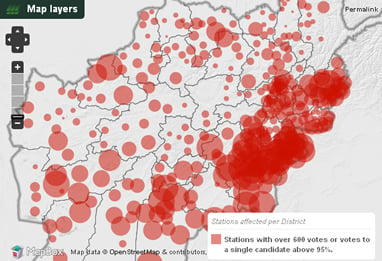
I visited DC a couple weeks ago and hung out with my close friend/doppelganger who works at the National Democratic Institute (NDI). She seems to have no end of interesting projects, but one of her latest, mapping voter data from Afghanistan's November 7 elections, in partnership with DevelopmentSeed, is really amazing. You can play around with some of the results at Afghanistanelectiondata.org.
The issues barring democratic civic engagement in Afghanistan are obviously different than the ones that we face in the US. I think the lesson here is that you have to identify data collection/visualization with a heavy dose of political strategy that's connected to influencing the change you want to see. She and I bandied this around a bit; she's a master at political strategy and can talk you through/out of anything you might think is a brilliant idea (<3 her!)
OK, duh I know, but how many times has data been collected/analyzed/visualized to look cool but still doesn't seem to say very much or remains disconnected to advocating for change? For example, I'm looking at the viability of inserting health impact assessments (HIA) into the planning process for local development projects. Yes, conceptually it totally makes sense. But when you drill down, identifying the most valuable public health indicators becomes really hard. Plus, what difference would a HIA make in NYC's ULURP or CEQR process without advocating for changes in those outdated processes as well?
It doesn't matter how big or small the project is; identifying the specific data needed to create the change in the specific political/cultural context is absolutely necessary. Sometimes simple is good, or the best. Getting to simple specifics is the hardest part of the thought process.
(Whoo-hoo, congrats cc!)
12.23.2009
Opening up process with open (specific) data
Posted by Shin-pei at 7:53 AM
Subscribe to:
Post Comments (Atom)
0 comments:
Post a Comment